#pathfinder skald
Text
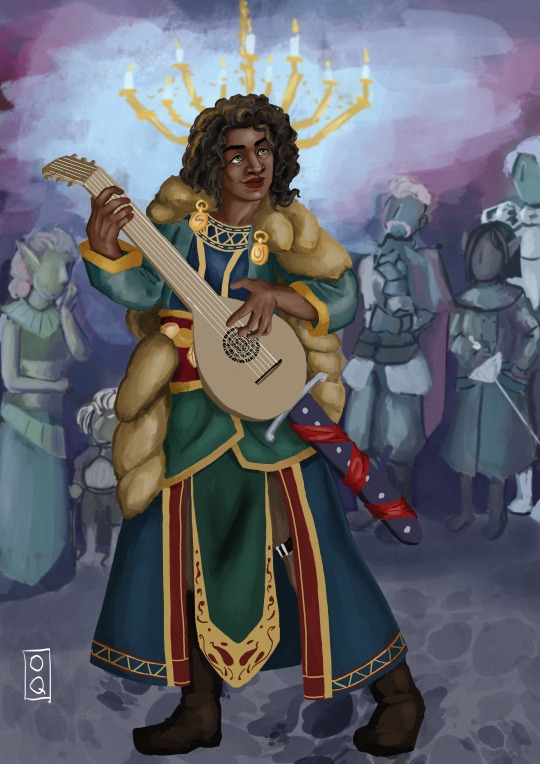
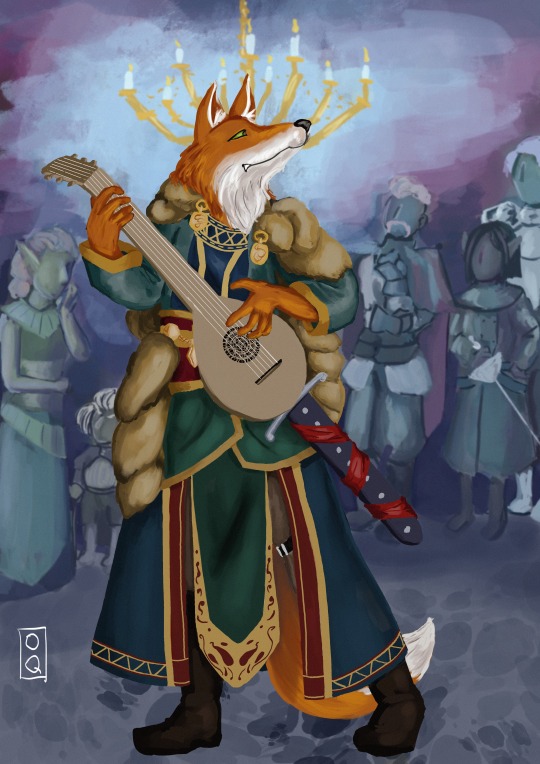
This was probably the first art I did of my Wrath Of The Righteous Knight Commander, around November last year. Polished this a bit now because his face was all wonky and I want to use it in a in-game portrait.
I named him Shinji Ikari because I didn't think. And kept the name because it's painful and horrible and unfitting and funny. I love it so much.
#pathfinder#pathfinder wotr#pathfinder kitsune#kitsune knight commander#pathfinder wrath of the righteous#pathfinder art#pathfinder wotr art#pathfinder skald
28 notes
·
View notes
Text
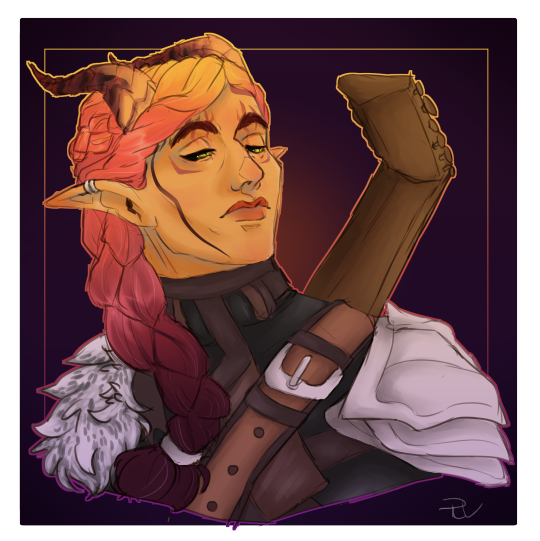
Joy! Boy be upon ye!
Naesala for @transprincecaspian
32 notes
·
View notes
Text
ive currently filled up three pages of a journal trying to plan cyrus' new build L M A O
#cyrus wotr#pathfinder i love you and i hate you#and its hard to experiment with things#(ie seeing if skalds can take rogue talents that require sneak attack if they have sneak attack from another source like a level of rogue#which they can)#bc the reclassing interface is a pain in the ASS#you have to remake your entire character. design and all.
6 notes
·
View notes
Text
Hunt Caller (Skald Archetype)

(art by KarinaKruglova on DeviantArt)
Songs are, by their very nature, meant to inspire emotion. Exactly what emotion varies a lot, ranging from sadness to joy to love to lust to even primal fury.
That last one is what today’s subject focuses on the most, for these warrior muses seek to bring out the beast in their listeners in a quite literal fashion!
Hunt callers use the magic of their music to briefly let their allies take on bestial forms if they choose to accept the power, potentially turning them into mighty war beast for an extended period.
With that in mind, I imagine they are most common in cultures with a deep focus on animals in their spirituality and aesthetics. Tribes of barbarians that favor the animal totem, beastkin enclaves, or even more civilized settlements where the nobility take the symbology of the animals on their heraldry very seriously.
Anywhere where the magic of skalds interlaces with the power of nature around the subject of animals is where you’ll find them, and in the right circumstances they can be deadly battle heralds rushing in alongside warriors in the guise of powerful predators and mighty beasts.
This path grants a few unique songs for the hunt caller, the first one inspires the listeners to enhance their senses, improving their night-sight and ability to notice the unusual. It also takes very little effort or energy, allowing them to maintain it for hours.
The real meat of their abilities, however, is a song that allows them and others to transform into the same animal form. At first this is that of a small animal, but later graduates to human-sized and beyond. They can even use it to emulate a more flexible polymorph including monstrous humanoid forms. What’s more, they can keep this up for an extended period even while in the animal form!
Given how their magic clearly blurs the arcane with primal traditions, these skalds add a small selection of druidic spells to their arsenal over time.
Later on, those benefiting from their songs also gain an enhanced sense of smell, even if the form they took doesn’t normally has such a sense.
This archetype has a list of recommended rage powers, which include the beast totem, and those that enhance the ability of the user in physical, primal ways, as well as striking fear into foes.
The ability to grant animal forms for hours at a time is very impressive, but remember that being polymorphed also removes many of your normal abilities a lot of the time, so it is best used for both the utility benefits and for when the party’s normal tactics won’t cut it against a particular foe and they need the buff. Just don’t forget that your inspired rage also has it’s own set of buffs as well, and deciding which to use is a big part of the class. Just remember that an animal constantly making rhythmic sounds might tip some off that something unusual is going on.
With an archetype like this, one has to think not only of what forms are practical for different things such as combat, travel, or the utility of certain special abilities, but also what sort of animals your character reveres or thinks highly of. A Hunt Caller in a noble house might favor lions, boars, or eagles, while someone living on the coast might favor sharks or seabirds.
For years, the hunt caller Vocus has been a dutiful servant of the Hunger, what he thought was a nature cult devoted to hunting and consuming in reflection of the aspects of nature, and he was happy to serve them. However, in recent years he has begun to realize the true nature of the faith he has been serving: a cult of Thuskchoon, the qlippoth lord of unending mindless hunger and strange insight. And all his expeditions for them have been purely for them to experience devouring the world in different anima guises.
Being small creatures with nevertheless monstrous appetites, grindylows often find the way of the hunt caller appealing, letting them borrow the power of the most vicious predators in the sea when they need it. Thus has the Bloodtooth clan been terrorizing coastal settlements as sharks, barracuda, and even once as a giant octopus.
House Vaka has long held the wolf as their heraldic symbol, and there are rumors that there are actual lycanthropes in their bloodline. While it is true that many among them are beastkin, the real source of those stories lies in their tradition of “wolf-singing”, taking on the form of wolves and dire wolves with ancient bardic arts.
#pathfinder#archetype#skald#hunt caller#thuskchoon#grindylow#beastkin#lycanthrope#dire wolf#wolf#ultimate wilderness
7 notes
·
View notes
Text
CUCXRA -> RUNESKALD
#↪〔 ☆ 〕 out of character talk#i wanted to be cheeky. i'm no good at choosing urls but#it's a funny joke of how skalds in pathfinder can incite allies into rage#and then there's cu-
3 notes
·
View notes
Text

Kendall got a new +1 dancing rapier forged from orichalcum sky metal. She's very excited to test it out
#player character#player character art#gm artist#character#character illustration#elf#skald#pathfinder#ttrpg#my art#digital art#krita#illustration#speedpaint
2 notes
·
View notes
Text

Vesryns long time bestie, criminal collaborator, and future partner! A pathfinder Skald (kinda like a bard/barbarian)- he meets the original group of heroes as they traveled abroad.
14 notes
·
View notes
Text
OC Profile—Liesel (from Pathfinder Kingmaker)
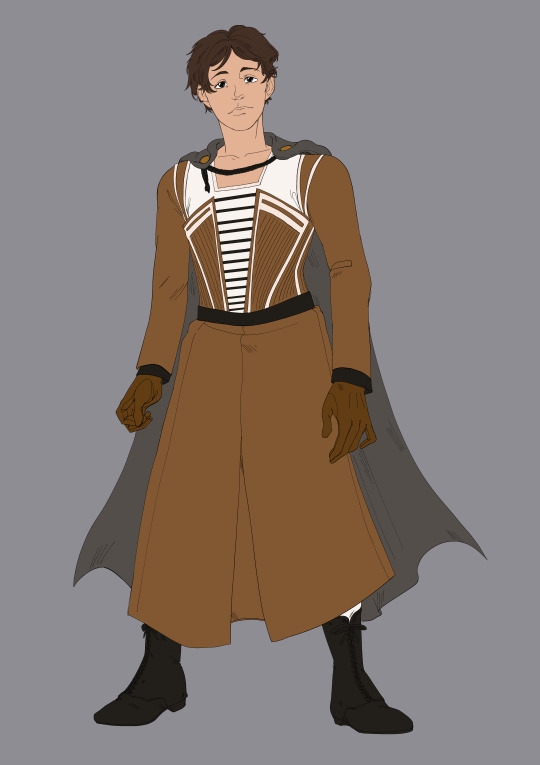
Art done by the wonderful @moyashidoodles ! Go commission them (if you want of course)
Name: Liesel
Aliases: Gertrud/Gertrud Elise (by the people who raised them); Ainsel (generic fake name given out)
Alignment: True Neutral
Pronouns: they/them
Race: "Human" (actually a fey)
Homeland: The River Kingdoms
Birthday: Neth 1
Religion: Formerly Erastil; currently none, but pays lip service (and a few coins) to Hanspur for the sake of safe travel
Class(es): Sorcerer (Fey Bloodline)
Professions: Spinning, weaving, etc (formerly); general farmwork on their family's farm and around their village (formerly); itinerant mercenary (formerly); Baron of the Stolen Lands (currently)
Languages: Taldane, conversational Hallit, a smattering of Skald and Varisian
(The rest is going under a cut because this is long)
Skills: As a result of spending most of their life in a rural farming village, Liesel has a fairly in-depth understanding of nature, despite not having an education that someone from a city would consider “formal”. Their mercenary work essentially forced them to become light on their feet in order to dodge blows from attackers they wouldn’t be able to withstand and to get out of melee combat so as to be able to safely launch their own, arcane, attacks. Whenever possible, though, they prefer to avoid combat, something they are surprisingly adept at despite their innate difficulty socializing, due to being in an environment where they felt their safety depended on spending agonizing hours studying the patterns of social cues and rules in order to mimic and exploit them (a process more like learning a foreign language completely unrelated to one’s birth tongue with no dictionary, or figuring out a complex code, than anything else), and due to an innate, extremely subtle, almost definitely supernatural effect on others (while they are skilled at masking in this way, it is incredibly draining for them; additionally, while they are good at assessing the situation and figuring out what people are expressing and how they are supposed to respond, this is very much an intellectual understanding, and they have pretty significant difficulty empathizing with others). They have an inexplicable aptitude with magical items, which they find uncommonly easy to detect and command the magic of. (In game terms: Lore (Nature), Mobility, Persuasion, Use Magic Device)
Romance(s): Octavia, Regongar, Tristian, Secret Romance
Appearance: Liesel appears to be a fairly average Riverfolk human in their midtwenties. Slightly wavy brown hair in a pixie cut frames a face with somewhat tan skin and black eyes that betray little of their emotions. Their nose is just the slightest bit upturned, and, although they often don't smile wide enough to show it for long, they have a gap between their two front teeth.
They dress comfortably and casually, in colors that blend into the background--almost exclusively shades of black, grey, white, and brown--and their outfit is always completed with their beloved gray cape. While this is very much practical, it is also done deliberately, so as to not bring attention to themself, or risk seeming odd.
They generally try to keep as much of their skin covered as possible, especially their hands--indeed, unless the situation absolutely requires they not, they always wear a pair of well-worn leather gloves. This serves both to prevent direct exposure to cold iron and to limit any unexpected unpleasant sensations.
Fighting Style: Although they are fairly athletic due to a life spent doing farmwork, Liesel is nonetheless a sorcerer, and thus stays out of melee combat on account of a) your average farmer not being a match for people specifically trained for combat and b) the gestures and focus it takes to properly channel their spells leaving them open to attacks from anyone too nearby. As a result, they stay on the backline of battle–although sometimes not as far back as they would like, given the limited range of many of their spells. They primarily focus on debuffing and generally causing problems for the enemy, whether with spells that directly do so (such as Sleep, Hypnotism, Entangle, and Scare), spells that do so in addition to dealing damage (such as Ear-Piercing Scream), or, occasionally, simply “debuffing” the enemy’s HP (read: using damaging spells to help even the odds against enemies resistant or immune to mind-altering effects, whether through significant or chip damage). They also wield a crossbow with surprising (but not at all remarkable) accuracy when necessary. When forced into close combat, they tend to default to using Laughing Touch to disable the attacker, then running away. Should that not work, they will reluctantly take out their +1 Cold Iron dagger (which they keep on (gloved) hand both to make sure that nobody else in the party could somehow use it against them, and to provide evidence why they couldn’t possibly be fey, just in case) and attack with the ferocity of a cornered animal.
Personality: Liesel’s personality is rather hard to pin down because, quite frankly, they’re so used to putting on a mask and playing a role that nobody, including them, has any idea what their true “face” would look like beneath. It’s much easier to define Liesel by the roles they’ve performed/are performing, both for practicality’s sake, and because the ways in which they adapt their behavior provide hints as to why they do so, glimpses at whatever it is that lies beneath.
For most of their life, they played the role of Gertrud Elise. The only child of two farmers, she had exhibited some odd behavior after experiencing a serious illness as a child, but had recovered to be known throughout the town as, in many ways, an ideal girl, and, eventually, young woman. She was kind, courteous, and always knew the exact thing to say when talking to others, but spent most of her time not socializing but working–often apart from others in the fields or pens, although she would sometimes join others at the loom. If there was no work to be done at her own family’s farm, she would even go work at others'. Nobody could resent her for the time spent away from others, for not being part of the community, not when she so clearly did it for them. And besides, it wasn’t as if she was a recluse–the time she spent away working was absolutely unusual, but it wasn’t extreme.
After fleeing their home village–and the simultaneously comfortably familiar and stifling nature of playing the same role day in and day out–and becoming an itinerant mercenary, Liesel began presenting radically differently in different situations, swiftly learning to assess the situation and adapt to be whatever was advantageous and needed for the job: the unflappable rock, the politely threatening negotiator, the detached and uncaring freelancer, et cetera. Since they worked with so many different people, and often under different names, there was no real need to maintain continuity. While it was radically different from what they had been used to, over the course of a few years, they got used to it.
As a result, being in the same group for an indefinite amount of time–as they have been since they accepted Jamandi Aldori’s quest–and thus needing to play the same role for an indefinite amount of time is an odd experience, both familiar and unfamiliar. “Liesel”–for, indeed, the name “Liesel” itself, which has no real special significance other than being the fake name they were using when they got word of an opportunity from the Aldori and thus being the one they are stuck with, might very well be seen as a part of this role–is a capable leader who always listens to others’ opinions and takes them into account (even if they don’t always act as others want), who is slightly uncommonly quiet and observant, but not at all stoic or severe–instead, they are rather carefree, simply not speaking up when there’s no need, content to let things flow along until they see a need to act or a true purpose for their input. They are skilled with words, whether in the form of their occasional jokes or in their deft handling of tense negotiations–and in the latter case they can reveal an ability to wield their words like a deadly weapon that sends foes sputtering and retreating without a fight. In one-on-one conversations with their companions, they are very personable, and give graceful compliments that often match exactly what the person wants complimented, to the point of flirtation at times. If this flirtation is rebuffed, they are completely without resentment, but if it is received positively, they will gladly go as far as the other person is willing to.
At times, however, they reveal another side–one far more wild. On a lighter level, this can be revealed when their emotions get the better of them and they do something impulsive and kind of silly. On a darker level, though, if an enemy is able to charge from the front line and engage them in close combat, they display a surprisingly vicious side, striking repeatedly and somewhat recklessly, willing to do anything to preserve their own life.
History/Hooks: (CW child death, low-key ableism, discussion of a trans person prior to their transition)
On Neth 1, 4684 AR, in the River Kingdoms, in a quiet farming village nestled between the arms of the Echo Wood, so small you would be hard-pressed to find it on most maps, a child was born and named Gertrud Elise. One day, not many years later, they ran out to play, past the rye-fields that surrounded the inner village, into the woods beyond, lured by the excitement and wonder of nature and too young and foolish to think they could fall victim to its dangers. They never came back.
(Had this never happened, this child would have grown into a gregarious, hearty man named Hedwirg. He would have become a mercenary in order to pay for an expensive transitioning potion, and eventually become known for the strength of his blows and of his moral code. But this happened instead.)
After a few days of frantic searching, the child’s parents found a child that looked just like their own in the woods, distressed and feverish and covered in soil. The desperate parents, who had feared their child would become another one of the stories used to warn children not to wander, didn’t question it.
When they recovered from the fever, the few memories they had at that age were somewhat hazy, as if they’d occurred years before they did, or were particularly vivid dreams. The parents didn’t question it, though–they were happy as long as they had their child back, regardless of whether that child was whole. Besides, while fey weren’t known for giving back what they stole, they were known even less for giving replacements–and it was perfectly plausible that the child had merely gotten lost in the woods. Any oddity or change was attributed to the trauma and the fever.
As the child called Gertrud grew up, they had trouble fitting in with others. Whispers of having been permanently “damaged” by whatever happened during their disappearance, or, rarely, of something worse, terrified them, and so, when with other people, they spent all their effort on figuring out how to behave so as to fit in. The act was more or less successful, but it was exhausting, and so they took any opportunity they could to limit the time they needed to perform by working whenever possible (whether in the farm, the house, or generally around town), earning them a reputation of being a good, solid, dependable kid whose selfless and helpful disposition balanced out any slip-ups that snuck out.
This continued into adulthood, until one day when a traveling merchant came by. While the adult called Gertrud didn’t really have wanderlust, per se, they always liked and were curious about things from outside the village, so they examined the wares. When they touched one item–a dagger–their skin burned with pain as if they’d touched freezing metal. They were not naturally very expressive, and practiced at hiding their feelings besides, so they concealed the reaction, and asked casually if there were any unusual wares. This was when they learned that the dagger was cold iron.
They made their excuses (easy, because they were known for being hardworking and didn’t have much pocket money), and left for the rye-fields, where they panicked. The whispers they and their parents had dismissed their whole life were true–hell, they weren’t even their parents!
Terrified that, if they had found out that they were fey, someday–maybe even someday soon–everybody else would, that night, they packed a small bag with a few necessities, left a vague note, and took off into the darkness.
As they traveled, going by a variety of fake names, they slowly discovered they possessed magical abilities. While they feared these abilities, and didn’t understand them–and especially didn’t understand how natural they felt–they proved incredibly helpful in the mercenary work they took up. Over the course of the next few years, they garnered a reputation that, while small, nevertheless earned them an invite and offer of a mysterious job proposition from one Jamandi Aldori in Rostland.
Unbeknownst to them, Liesel is the creation of the Green Mother, the Eldest of intrigue, carnivorous plants, seduction, and the urges that lead the unwary to their death. While they are very much flesh and blood, they were grown in the First World from a plant that was planted on top of the shallowly buried corpse of the child they replaced.
Trivia:
I often use common cuckoo (Cuculus canorus) imagery with Liesel, on account of their whole deal.
The name Liesel isn’t fundamentally special to them, other than deriving from the middle name they thought was theirs; it was initially just another fake name, but since they are in a situation where they will be using it for the foreseeable future, and it is used by people they are growing to care about, they are becoming attached to the name.
Some of the specifics of their backstory are inspired by German folktales about the Rye Mother/Rye Aunt.
The way in which Liesel grew from a plant is partially inspired by barometz from Dungeon Meshi.
Liesel’s whole “autistic but obsessively studied and takes advantage of social cues and social norms” thing is inspired by Nick from Hell Followed With Us.
Liesel is really good at weaving.
Liesel’s personality is partially inspired by Siffrin from In Stars and Time.
Liesel’s outfit is going to change significantly in later Acts as they progress their character arc.
If they existed in the modern day, they would be a huge fan of Kabru Dungeonmeshi and. Probably relate to him too much because they share a few very important and key traits despite being radically different people.
Liesel has very inconsistent–and some would say entirely lacking–principles, but one of their few consistencies is that they highly value the Six River Freedoms.
They believe strongly in religious freedom, and would have no issues, for instance, with someone worshiping Lamashtu, so long as they don’t, for instance, kill people about it. They would, in fact, struggle to understand why someone would have issues with a Lamashtan who wasn’t making their religion other people’s problem.
7 notes
·
View notes
Text
All my Pathfinder Blorbos
I did this for BG3, so here's all my Pathfinder CRPG characters in one place. The only art I own is for Hilde and Ethyn.
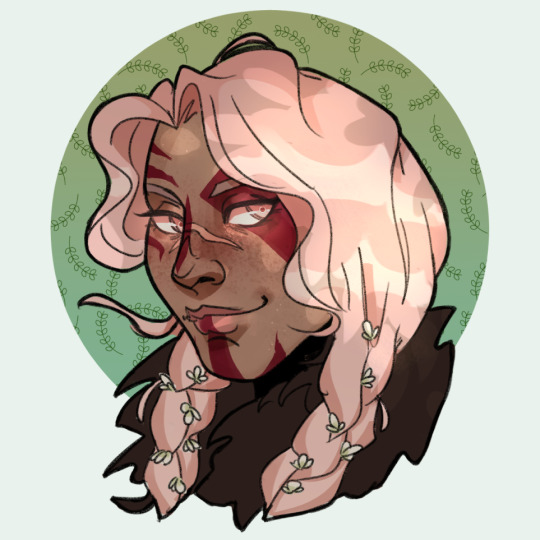
Hilde Svalksdottir, Musetouched Aasimar Skald. Demon Path, though she switches to Azata in Act 5. She's just a skald trying to make a name for herself who got roped into the Crusade. Romancing Arueshalae.

Nadia Karayan, Ajibachana Dhampir Grenadier Alchemist. Aeon Path. A half-vampire with a strong vendetta against the undead trying to keep balance. Romancing Daeran.

Ve, Sylph (half-elf) Eldritch Archer Magus. Angel Path. A wandering dancer and mage who ends up as the Commander of the Fifth Crusade. Romancing Sosiel.

Sakura Redpetal, Kitsune Inquisitor. Trickster Path. A devout follower of the Green Mother who enjoys the constant intrigue and espionage necessary when fighting demons. Romancing Camellia.

Ethyn Roseveil, Musetouched Aasimar Hospitaler Paladin. A paladin of Shelyn trying to turn her new barony into a bastion of peace, tolerance, and love. Romancing Nyrissa.

Aurora Brightsong, Human Overwhelming Soul Kineticist. A noblelady exiled from her home after loosing control of her power, now trying to learn how to control and develop her control over air and electricity. Romancing Kanerah and Kalikke.
18 notes
·
View notes
Text

The Path of the Skald - 5e Barbarian Subclass by Nines
"Skalds are poets, historians, and keepers of lore who use their gifts for oration and song to inspire allies into a frenzied rage." The Pathfinder description of a Skald gets used a lot in related homebrews.
And that's perfectly fine; it's a strong opening, and pays homage to the concept's progenitor. But as a barbarian, you know we're not here to be a scholar, to play with spellcasting, or to maintain a veneer of civilization. We're here to perform a death metal scream and lop off heads.
Links in reblog as always.
#my homebrew#barbarian#dnd barbarian#barbarian dnd#subclass homebrew#homebrew subclass#subclass#dungeons and dragons homebrew#dungeons and dragons 5e#dungeons and dragons#d&d homebrew#dnd 5e homebrew#dnd homebrew#5e homebrew#homebrew 5e#homebrewery#homebrew#dnd#5e dnd#dnd 5e#5e d&d#5e#d&d 5e#skald#dndbeyond#pathfinder
108 notes
·
View notes
Text
TVTropes - The Homunculus Children
I got inspired by @the-raging-tempest's post here, so I made my own mock post for the homunculus girls.
In General
Adopted into Royalty: Much of the story’s angst revolves around whether the girls will inherit the crown if Daeran formally adopts them.
All of the Other Reindeer: Most of the girls have trouble making humanoid friends.
Artificial Human: Each girl was created using a magical formula and seems to start at about ten years of age
Artificial Family Member
Badass Family: What they become when they grow up. Their parents are also very powerful adventurers.
Cute Monster Girl: The girls are all homunculi and are rather adorable
Four Temperament Ensemble: Opal is Sanguine, Giselle is Choleric, Grace is Melancholic, Talia is Phlegmatic. Magnolia is Eclectic
Happily Adopted
Little Big Brother: Except for Magnolia, who is very small and is the second oldest, each girl gets a little taller as you go from oldest to youngest (Giselle is fuming).
Mature Work, Child Protagonists: The girls are cute, but MLH is just as dark and mature as the two works it is a derivative of
Our Homunculi Are Different: The girls are strange even by Pathfinder standards.
Tears of Blood/Unable to Cry: The girls can’t cry normal tears. Half of them can’t cry at all, while some of them have substitutes (Giselle starts running muddy water down her face, and Talia has sand dropping from her cheeks).
Giselle
“Anger is Healthy” Aesop: For her, but also for Daeran, who she donates her Anger Affinity to. Despite being the Anger homunculus, more often than not, there’s always a reasonable source to her frustrations, and the story gives her plenty to be upset about.
Best Served Cold: Poor Elisel…
Big Sister Instinct: Is the oldest, and anyone who teases her younger sisters will earn Giselle’s ire very quickly
Girly Bruiser: Loves clothes, frills, balls, and all the girly stuff. She’s also the heavy-hitter of the group, specializing in large weapons when in combat training. Her character class (skald) encapsulates this.
Girly Girl
Jerkass Woobie: The rudest and most blunt of her sisters, but she deals with a lot of internal and external judgement because of what she is and what she is made of.
I Just Want to be Beautiful: Is very insecure about being a homunculus made of mud when she wants to be a pretty princess.
Little Miss Snarker: Is able to match her father in witty banter.
Princesses Prefer Pink/Graceful Ladies Like Purple: Often wears pink or purple dresses.
Regal Ringlets: Has some pretty impressive curls, and her greatest ambition is to be a princess.
Square Race, Round Class: A homunculus made from mud who becomes a more ladylike Court Poet
Token Evil Teamate: Definitely the more ruthless and vengeful of the sisters. It gets even worse when she grows up and marries an unscrupulous vampire marquis.
Tsundere: Rough, demanding, and difficult to please, but she does care very much.
Unholy Matrimony: With Radomir when she grows up.
Magnolia
Alchemy is Magic: Becomes an alchemist when she grows up.
Brilliant but Lazy
Daddy’s Girl: Is very close to Daeran, despite their differences.
Goth: Wears black more often than not.
Feminine Mother, Tomboyish Daughter: A lot more sloppy and ragged than the refined and graceful Leonosa.
Lack of Empathy: Has difficulty with cognitive empathy due to her autism.
Strict Parents Make Sneaky Kids: Lenarius is a very strict parent. Magnolia spends her time going off and getting into places she’s told not to be.
Strong Family Resemblance: Since Lenarius used his/her own blood in Magnolia’s creation, she takes a lot of traits from him/her
Opal
Badass Preacher: Her character class when she grows up is a cleric of Iomadae.
Cheerful Child
Creepy Good: A genuinely good person, just a bit unsettling.
Major Injury Underreaction: Takes getting impaled in the chest with a gardening implement very well. She also recounts one time where she didn’t notice she injured herself on her way to a lesson and gave the instructor a fright when she walked in with her arm bent in an unnatural angle.
Plucky Girl: In keeping in line with her Joy Affinity, she is a very cheerful and kind girl. And too energetic for her own good.
Token Good Teammate: The only Good-aligned sister (Giselle is Evil and the other sisters are Neutral; this could also count for the family as a whole, as Daeran is Evil and Lenarius is Neutral)
Uncanny Valley Girl: The most kind and sociable of the girls. She can be a little unsettling sometimes, particularly when she doesn’t understand that it is not normal for a girl her age to be sustaining the injuries she’s had.
Wacky Parent, Serious Child: Has this relationship with Daeran. The only time he’s ever been disappointed in the girls was when Opal asked him if he would let her go to church on Sundays.
Wide-Eyed Idealist: Never thinks ill of anyone and is the only one of the girls to try to reach out to their grandmother, the Viscountess
Grace
Afraid of their Own Strength: Afraid to hurt someone with her spikes.
Cowardly Lion: Is easily scared, but was the first to volunteer to try out the Affinity-harvesting machine Xanthir and her mother created.
Fear is Normal: What she gives to Daeran when she donates her Fear Affinity to him. Also, much like Giselle, while she is easily scared, she often has justifiable reasons for her fear.
Flowers of Feminity: Is quite girly and loves to wear flowers.
Fragile Speedster: Trains to be a Slayer, a Dex-based martial class.
Nervous Wreck: Appropriate, for a Fear homunculus.
Plant Person
Cactus Person: Made from branches of an acacia tree instead of an actual cactus, but the effect is still the same.
Innocent Plant Children: She is a ten-year-old girl and acts like one.
Botanical Abomination: Her appearance frightens even herself when she looks in the mirror for the first time.
Poisonous Person: Downplayed. Getting pricked by one of her spikes will leave a rash.
Swashbuckler: A skilled fencer and a proficient Pathfinder when she grows up.
Talia
All Girls Like Ponies: Is very fond of horses
Big Beautiful Woman: The largest of the homunculus sisters and very beautiful.
Following in the Relative’s Footsteps: Becomes Leonosa’s apprentice and grows to be an exploitation wizard
Indifferent Beauty: Is very beautiful, but not really interested in romance or people.
Mature Younger Sibling: Though she’s the youngest, she is seemingly the smartest and most put-together.
Squishy Wizard: Becomes a wizard, and her glass body is quite fragile.
The Eeyore: Keeping in line with the Sadness Affinity. Talia is very pessimistic and is prone to point out the worst case scenario of any given situation.
The Smart Guy: Is very good at mathematics, formulae, and memorization. She is the one who trains to be a wizard.
8 notes
·
View notes
Text
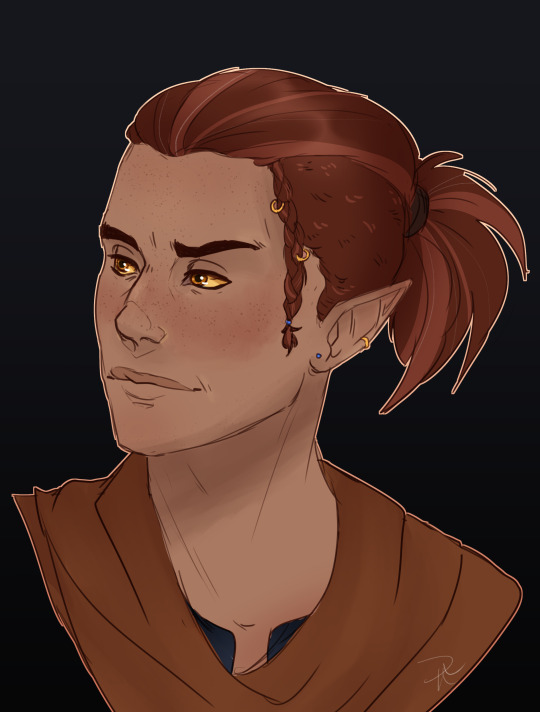
Musetouched aasimar skald for an upcoming pathfinder game (since another I was playing in got put on hiatus kind of). Also a neverwinter nights oc, because I wanted to play that too heheh.
His name is Joran, and he was raised by dwarves. uwu
I'm tempted to change his appearance to make him more lillend-esque, since he's descended from one. Not sure how though, but I'm open to suggestions!
16 notes
·
View notes
Text
you don't have to know pathfinder classes or mythic paths just vote for the one that sounds coolest
#pathfinder wotr#my first playthrough is chaotic good azata#which was absolutely perfect. i fucking love azata path.
5 notes
·
View notes
Text
Roleplaying Races 15: Naiad
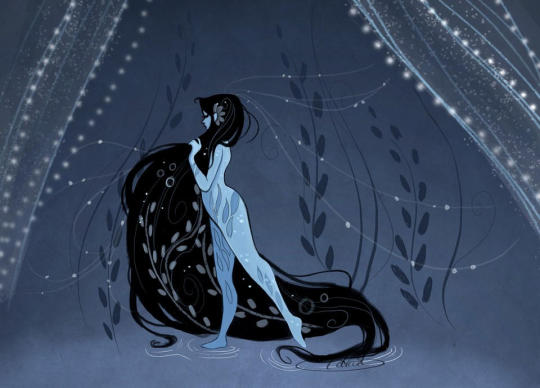
(art by Celiarts on DeviantArt)
I’ve said it before, but there are a handful of playable ancestries in first edition which got a blurb in a bestiary, but was never really touched again.
This is technically true of today’s entry: the naiad, but Paizo didn’t completely forget about them, as they show up again in 2E… admittedly with monster stats and only the lore drop of them occasionally becoming adventurers, but no ancestry stats… not yet, anyway.
In any case, naiads!
In Greek mythology, Naiad are a type of nymph, minor female deities that preside over aspects of the natural world, either independently or in the service of a more powerful divinity that rules more generally over the nymphs more specific focus.
In particular, naiads were the guardians of all bodies of freshwaters with the exception of full rivers, which had their own divinities. Anything from streams to fountains to ponds and lakes. Anywhere that fresh water could be found was their domain. They were known to be healers and protectors to those that honored them, but also dangerous and sometimes jealous beings, but that’s true of many Greek divinities.
In Pathfinder, naiads are a form of lesser nymph, able to bond with any body of water, rather than just being stuck with one on their moment of birth. As such, they tend to wander much further afield than other nymphs (with perhaps the exception of their more oceanic kin.)
That wanderlust and keen interest in protecting waterways and sources of fresh water means that many naiad take up the life of adventure to grow in strength and defeat evil that seeks to pollute and corrupt.
As fey creatures, naiad have a decidedly otherworldy appearance, appearing as humanoids seemingly made of water, and often adorning their forms in clothing made of living aquatic plants. Despite their appearance, however, they are very solid beings, and can come in a variety of genders despite the stereotypes of supposedly being only female.
As both fey and wanderers, Naiads don’t typically have societies of their own, though they probably pay homage to more powerful nymphs and to local fey courts when they’re in the area. Their wanderings also place them in greater contact with mortals too, so they likely have a better understanding of the mortal mindset as they interact with and integrate with their societies. They still are fey, however so their worldview no doubt clashes sometimes. They do, however, share a love of music and performance, as evidenced by the nature of their blessing when bestowed on a mortal.
Naiads are agile and charming, though their bodies are somewhat weak.
Their fey nature also gives them good night vision as well.
What’s more, being in tune with nature lets them befriend animals easier and understand the natural world.
True to their nature as nymphs, naiads can imbue a small token of favor, typically a lock of hair, which grants a minor blessing to creativity and mental integrity to the one it is gifted too. What’s more, the link between the naiad and their token lets them keep tabs on the well-being of the recipient, and they can rescind this blessing at any time.
The other iconic ability of theirs is the ability to bond with a freshwater body of water. As long as they are within a minute’s run from this water, the naiad draws protection from it, warding them against mundane and supernatural attack.
Charisma and dexterity are fun bonuses to have, making these fey surprisingly good swashbucklers. As fitting for their nature as minor muses, they also make good bards and skalds, to say nothing of their mastery of sorcery, the talents of a rogue/slayer, and so on. What’s more, their tokens and ability to draw protection from water makes defensive magic and water magic good themes to explore as well. Their only real weakness is the low strength, but that’s easy enough to surmount.
That does it for today, but we’ll be ending off with one more ancestry orphaned by the bestiary book it was introduced in!
14 notes
·
View notes
Note
1, 4, 15, 22 👀 for the pathfinder ask game :)
yayyyy - questions are here - I have two KCs right now, my original one who I've reworked from dhampir to bleached gnome, currently I'm adjusting her bit by bit. I'll have to rename and respec her, but I would answer as she is in game, a winter witch on the lich path. I'm playing with the idea of a diva on the azata -> devil path so quite the difference. my other one is Radif the aasimar skald. quite simple tbh
1. What led the future Knight-Commander to take their base class?
K: witch, a pact for power as a helpless youth... on the other hand bard, desire for fame and something more. wanting to go beyond what was expected of her and what her little town has to offer her
R: skald, akin to bard but I chose it specifically for the court poet subclass. wish to be recognised in the upper classes as someone raised by parents who served the local nobles. and a love for arts
4. What prestige classes did they go for, and why? If not, would one fit them or did they qualify for one?
K: winter witch, embodying the ice queen. could be hellknight signifier after going devil... that idea would disgust her initially
R: could be loremaster if he wizened up. maybe when he's older
15. In your story, does the Knight-Commander consciously choose their mythic path at Drezen, or was it thrust upon them by their actions or some other outside force?
I definitely play it as them choosing... not as clear-cut as picking a menu option in game but shaping it over the course of the act into what motivates them, if that makes sense. for Koska initially it was the promises of the lich mentor that made her consider this option
22. What is the Commander’s opinion of their mythic patrons/advisors - the Hand of the Inheritor, Aivu or the Desnan Adepts, Zacharias, the Aeon in the mirror, Hal, Yozz and Noticula, etc.?
Koska in the lich path regarded her advisor skeptically... but was deferential to him since she wanted to learn all she could. now if choosing azata we'll see, I think she wouldn't be amused. she's a rather jaded older lady with regrets. but keeps it all under wraps
#tyyyy :3 aasimar boy i love you but he's still in the prologue so i have more backstory thoughts. but i need to chill with shyka the many#answered#oc tag#wotr tag
2 notes
·
View notes
Text
Pathfinder Iconics Comparison Part 6: Who's left?
[Part 1: Classes with Different Iconics]
[Part 2: Core Classes]
[Part 3: The Remaining PF2 Classes]
[Part 4: Classes Who Got Demoted]
[Part 5: Prestige Classes]
And so we come to the end of our journey. It's been a ride. Out of forty total classes in PF1, only twelve* remain that we have yet to examine.
* Only twelve classes, but we actually have 17 Iconic characters left to look at, more on that later
Hybrid Classes


Top: Crowe (Bloodrager, he/him), Kess "The Bull" (Brawler, she/her), Adowyn & Leryn (Hunter, she/her)
Bottom: Hakon (Skald, he/him), Zadim (Slayer, he/him), Oloch (Warpriest, he/him)
Half of the remaining classes are Hybrid classes from the Advanced Player's Guide. The Hybrid classes, as I've mentioned before, are meant to blend two "parent" classes, taking features from both but creating a play experience that is distinct from either. Some of these achieved their goals better than others.
A lot of the game design space that was occupied by the hybrid classes can now be filled by PF2's multiclassing system. While in PF1 it was often preferable to pick, say, Bloodrager over a Barbarian/Sorcerer multiclass, in PF2, the Archetype feats make it easier to do so. With just a few feats, a Barbarian can gain spellcasting abilities from the Sorcerer without losing any of their potency as a frontline fighter.
If I were a gambling bun — and let's be real, I spend most of my time playing games with dice — I'd say we won't be seeing the Hunter or Warpriest again as full classes in their own right. It seems like one of Oloch's parents got full custody.
In PF2, the Warpriest is one of two Doctrines that can be taken by the Cleric, sacrificing some magical potency in favour of increased martial prowess. Similarly, the niche formerly occupied by the Hunter is now occupied by certain Ranger abilities.
The Hunter was a Ranger who lost some combat focus in exchange for starting with a pet, like a Druid, rather than having to wait until Lv.4. The PF2 Ranger can start with a pet, making the niche formerly occupied by the Hunter pretty redundant.
As for the others, never say never. Even if they don't show up as classes, Paizo might surprise us with archetypes. And Oloch has already shown up in Hollow Mountain as a member of Seltyiel's adventuring party (along with Damiel and Meligaster) so it's not impossible that they might show up in future comics or books.
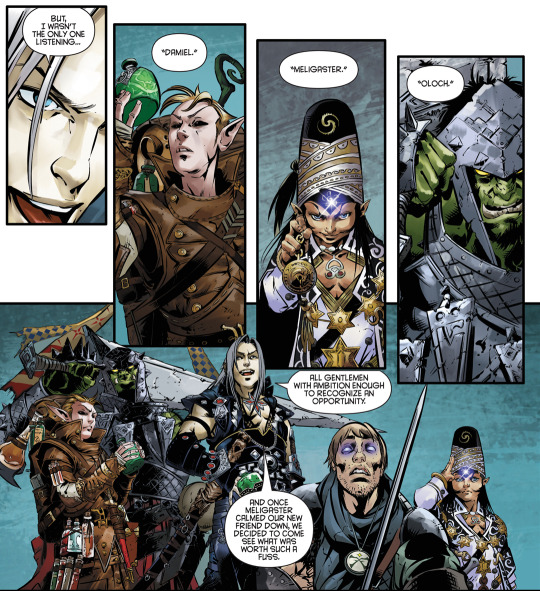
I feel like I sort of cheated with Shardra and maybe she should also be included here, since she wasn't used for a character option.
Occult Classes

Erasmus (Medium, he/him); Meligaster (Mesmerist, he/him)
The Kineticist and Psychic appear in PF2, while the Occultist and Spiritualist have successors in the Thaumaturge and Summoner, respectively. That leaves only two of the classes from Occult Adventures without representation in PF2. The Medium and the Mesmerist.
The Medium can channel spirits of the dead to gain their knowledge and skills for a time, manifesting in-game as bonuses to specific types of rolls.
The Mesmerist uses psychic magic to control the minds of others. Meligaster appears in Hollow Mountain as a member of Seltyiel's adventuring party, and shows off his mastery of psychic control.
Erasmus's glowing yellow eyes really sell the "possessed" angle, and the grey hair streaking his temples hints at continual psychic stress. I love his array of unconventional tools: the ouija board and planchette, the crystal ball, and the handful of... Harrow(?) cards, all very neat for divining and communing with the spirit world. He's also incredibly fashionable. It takes a brave man to wear a cravat and a scarf but he pulls it off.
Meligaster's appearance is great, I love his tall hat and the hypnotic, swirling spiral patterns on his clothes. Wayne did a great job of making his stare really intense, which is what the Mesmerist is all about. He really fixes his gaze upon the viewer, making it hard to appreciate the other fine details in his costume.
I'm not betting on these two classes making a return any time soon but I wouldn't rule out the possibility of Meligaster coming back in the story; he's the long-lost brother of Lem, the Iconic Bard. There's a fair bit of bad blood between them so I could see that getting resolved as part of a future storyline.
Alternate (Eastern) Classes
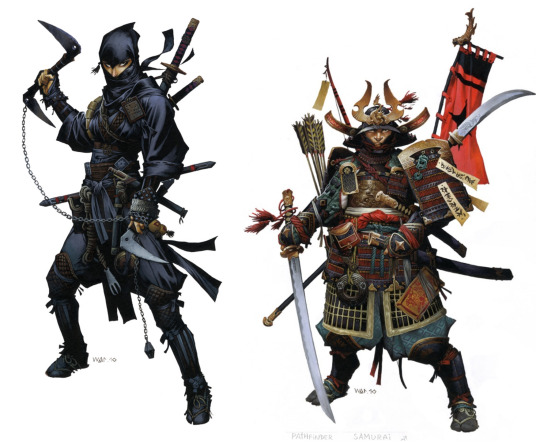
Ninja (Reiko, she/her*), Samurai (Hayato, he/him)
* Liz Courts, author of Meet The Iconics: Reiko stated in this messageboard post that Reiko is a female-presenting genderqueer/genderfluid character, but was not speaking in the capacity of a member of Paizo's editorial staff at that time. Reiko's gender identity is thus not canonically confirmed.
These are two Alternate classes from Ultimate Combat. The Ninja is an alternate Rogue, and the Samurai is an alternate Cavalier. Essentially, they take the basic class and swap out a couple of features here and there while keeping the core unchanged. The Samurai gets a mounted archery ability, for example, whereas the Cavalier gets the ability to train horses more easily; and the Rogue is better at finding and disarming traps, but the Ninja becomes adept in the use of poisons.
I think Wayne's signature style of "give them a tonne of stuff to carry around" really does good work for these two. A samurai who's armed to the teeth, or a ninja with the right tool for every occasion are both great. I think Hayato might be wearing a scabbard upside-down, though? If it's a katana, they were typically worn with the edge facing up, though it is also just a question of the personal preference of the wielder.
These two haven't shown up in PF2 yet, but I think it's only a matter of time. Next year, we're going to be getting not one, but two books about the continent of Tian Xia, the Asian-inspired region of Golarion. We'll be getting a World Guide and a Character Guide. We might see Reiko or Hayato over there, as background characters, class options or archetypes. Watch this space I guess
Base Classes
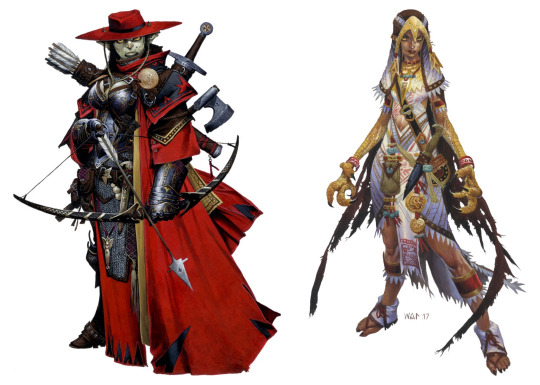
Inquisitor (Imrijka, she/her), Shifter (Zova, she/her)
And now we come to the last two player classes. The Inquisitor was introduced in the Advanced Player's Guide (2011), and the Shifter in Ultimate Wilderness (2017). Imrijka has been around a while and appeared in plenty of art, being featured in comics as recently as 2019. Zova, meanwhile, is much younger (in game terms). The Shifter was the very last class to be introduced. Ultimate Wilderness was the penultimate PF1 sourcebook line before the launch of Second Edition so Zova wasn't around very long before the writers started to focus on PF2 stuff.
The Inquisitor is an agent of their faith, tasked with tracking down threats to the orthodoxy, whether they are external (as in the case of devils and demons) or internal (such as corrupt priests).
The Shifter is... a shapeshifter, they can assume the form of an animal. They're kind of like a Druid, if Wild Shape was the main thing that that class did rather than just being one of many.
Though she's appeared in comics recently, I wonder if the unfortunate implications of Inquisiting are the reason we haven't seen the class in PF2 yet. The class description is:
Grim and determined, the inquisitor roots out enemies of the faith, using trickery and guile when righteousness and purity is not enough. Although inquisitors are dedicated to a deity, they are above many of the normal rules and conventions of the church. They answer to their deity and their own sense of justice alone, and are willing to take extreme measures to meet their goals.
Role: Inquisitors tend to move from place to place, chasing down enemies and researching emerging threats. As a result, they often travel with others, if for no other reason than to mask their presence. Inquisitors work with members of their faith whenever possible, but even such allies are not above suspicion.
Advanced Player's Guide (2011), p.38
And... yikes? A small yikes. One singular yike. I like the idea of an Inquisitor-type class, there's a lot of interesting stuff you can do with a character whose only motivation is to root out corruption, like an Inspector Javert kind of thing. There's definitely space for that kind of character in PF2, it's the kind of character lots of players want to play. But in practice I worry that allowing such a character class, especially in organised play, might create unnecessary friction between players. The fact that the class description includes the phrase "extreme measures" was possibly enough to leave a bad taste in some people's mouths. It's a class that I like conceptually but I feel needs to be handled delicately to avoid upset.
It is still early days, though. PF1 was around for ten years and we're only into year 5 of PF2's existence. We might yet see the Inquisitor again.
The Shifter is a class that I think there is room for in PF2. There are already a bunch of feats and ancestry features that allow players to gain specific unarmed attacks by shapeshifting a little bit, so having a class that focusses on that seems like a no-brainer.
That being said, I feel like if they were going to bring the Shifter back, the upcoming Howl of the Wild book would be the perfect place to do it, and we've heard no mention of a Shifter in the preview material for that. Howl of the Wild is going to focus on seven new characters so maybe having Zova as well would be too much. I guess we'll have to see. It's definitely not the last opportunity for a Shifter to appear.
Zova is still kicking about. Here's an illustration from Lost Omens: The Mwangi Expanse where she just seems to be having a nice meal with some friends.

Iconic Villains

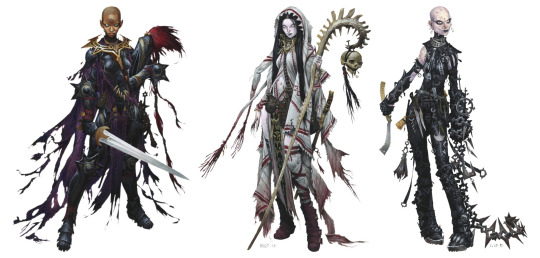
Top: Emil (Assassin/Rogue, he/him); Lazzero (Cleric of Asmodeus, he/him)
Bottom: Linxia (Fighter/Hellknight she/her); Nyctessa (Necromancer Wizard, she/her); Zelhara (Inquisitor, she/her)
We've seen Urgraz, the Iconic Antipaladin, already, but he's only one of a line-up of iconic villains designed by Wayne Reynolds. None of these is a unique class; instead they were created for the Hell's Vengeance Adventure Path where the players are the baddies, a fun little inversion. I know lots of people love the idea of playing an all-villains game but never get round to it. Having a single Evil character in a party can end up being very disruptive, and I think having an all-Evil party might be difficult for the Game Master to navigate.
These five, plus Urgraz, have also appeared in the Pathfinder Adventure Card Game but I can't comment one way or another about that because I've never played it.
---
At time of writing (23/08/23), Paizo has promised us a playtest preview of two "fresh, new" classes at the end of the month. I guess we'll have to wait and see just how fresh the faces are, we might see someone we recognise.
As for the rest, I do wonder if we'll see them again in PF2 material. I know that many of the Iconics are really popular among fans. There exists tonnes of cosplay, fan art, fan fiction and so on using all of these characters. People like having a diverse cast of blorbos that they can draw from, inventing little interactions or scenarios. There's probably a non-zero number of Lem X Ezren shippers out there.
Paizo recently established Pathfinder Infinite, an official distribution platform where fans can create original fiction using the canon characters and setting. I think it'd be interesting to see the relative frequency of the Iconics, who gets used regularly and who not at all. I remember Fanfiction.net used to allow you to see the number of fics written for a given character.
While I was putting this post together, a friend asked if I was planning on putting together similar posts about other non-characters such as archetypes, but unless I limited the scope of such a project somewhat arbitrarily (e.g. only tackling rulebooks and not campaign setting or adventure path stuff) it would quickly grow out of hand. I guess I'll think about it? I never planned when I set out on this quest to become the authority on Pathfinder characters. I also don't know how interesting it would be, since most of those sorts of character show up exactly once, maybe I'd limit myself to only characters who appear two or more times.
But that's another story for another time. That's yer lot for now.
12 notes
·
View notes